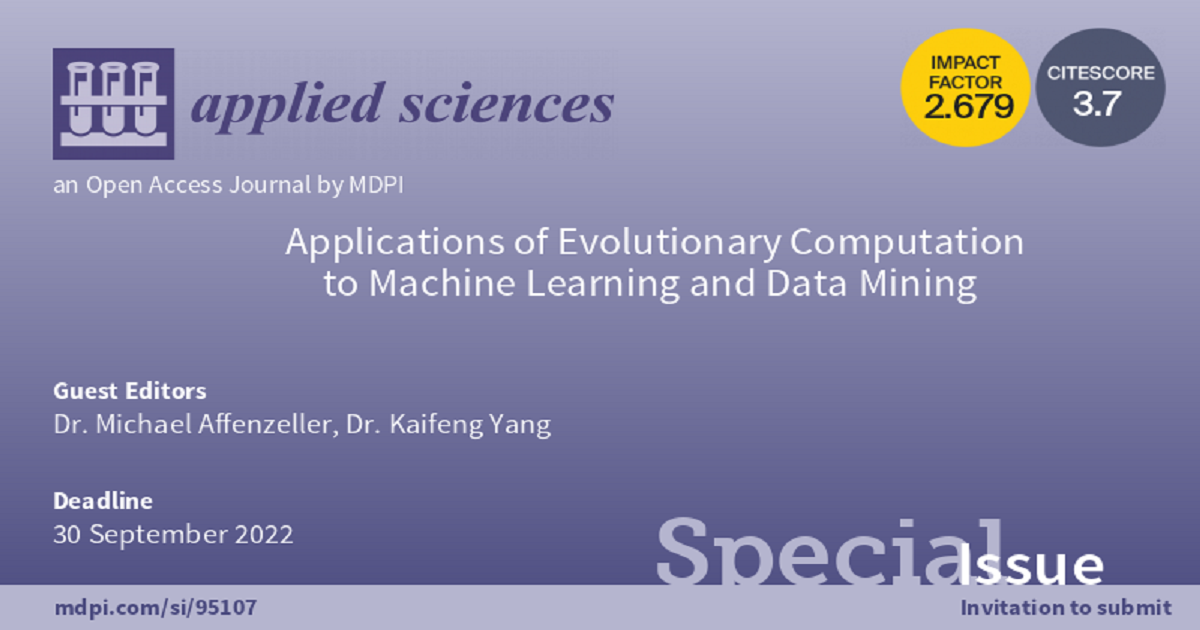Applications of Evolutionary Computation to Machine Learning and Data Mining
A special issue of Applied Sciences (ISSN 2076-3417). This special issue belongs to the section "Computing and Artificial Intelligence".
Deadline for manuscript submissions: closed (30 September 2022) | Viewed by 11594

Special Issue Editors
Interests: evolutionary computation; genetic algorithms; genetic programming; machine learning; data-based modeling; explainable ai; prescriptive analytics
Special Issues, Collections and Topics in MDPI journals
Special Issue Information
Dear Colleagues,
The potential interactions between evolutionary computation and machine learning are manifold and are further advanced by recent developments in the areas of human-centered AI as well as interpretable and explainable AI. Application perspectives often arise in but are not limited to manufacturing, logistics and product design. In terms of applications, there are strong connections to industrial AI, and in terms of methods and algorithms, there is a close relationship with predictive and prescriptive analytics.
A particularly prominent example of this field is symbolic regression, in which complex nonlinear relationships can be identified from data using genetic programming, whereby the models are mathematical formulas that can be interpreted. More and more example applications show that approaches such as these are often superior exactly when the system to be described by data has a natural scientific background, where mathematics can particularly bring out its special strengths as a universal descriptive language.
In the data-based generation of surrogate models, as often practiced in simulation-based optimization, evolutionary algorithms can be used both on the optimization side and on the machine-learning side. Further examples in this environment are the topology optimization of neural networks with genetic algorithms or the anticipation of dynamic systems’ behavior in optimization by means of machine learning.
Dr. Michael Affenzelle
Dr. Kaifeng Yang
Guest Editors
Manuscript Submission Information
Manuscripts should be submitted online at www.mdpi.com by registering and logging in to this website. Once you are registered, click here to go to the submission form. Manuscripts can be submitted until the deadline. All submissions that pass pre-check are peer-reviewed. Accepted papers will be published continuously in the journal (as soon as accepted) and will be listed together on the special issue website. Research articles, review articles as well as short communications are invited. For planned papers, a title and short abstract (about 100 words) can be sent to the Editorial Office for announcement on this website.
Submitted manuscripts should not have been published previously, nor be under consideration for publication elsewhere (except conference proceedings papers). All manuscripts are thoroughly refereed through a single-blind peer-review process. A guide for authors and other relevant information for submission of manuscripts is available on the Instructions for Authors page. Applied Sciences is an international peer-reviewed open access semimonthly journal published by MDPI.
Please visit the Instructions for Authors page before submitting a manuscript. The Article Processing Charge (APC) for publication in this open access journal is 2400 CHF (Swiss Francs). Submitted papers should be well formatted and use good English. Authors may use MDPI's English editing service prior to publication or during author revisions.





